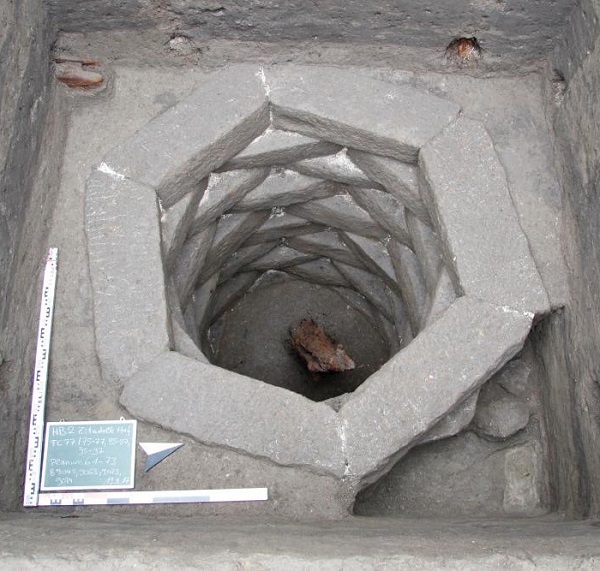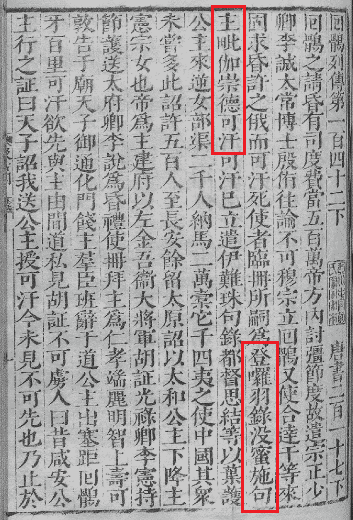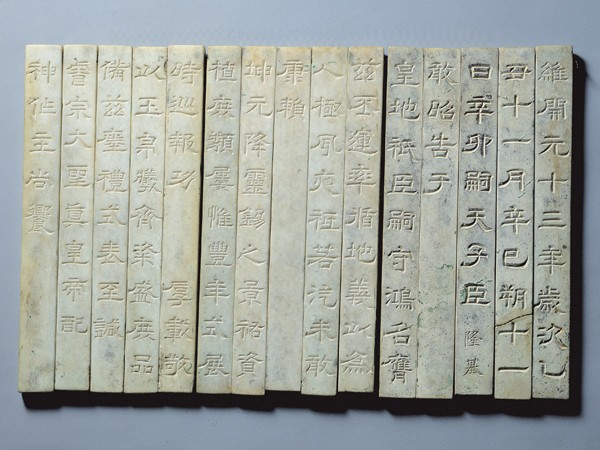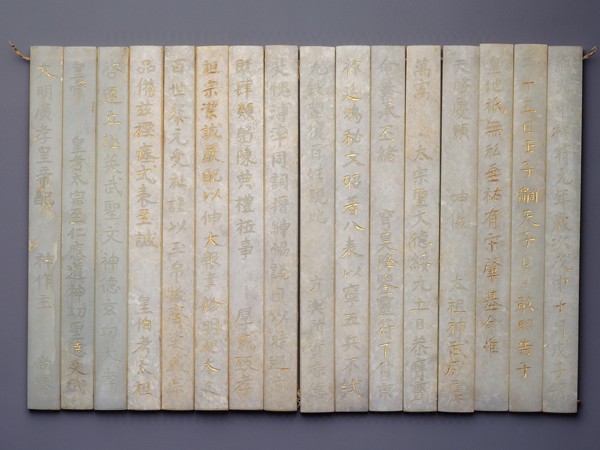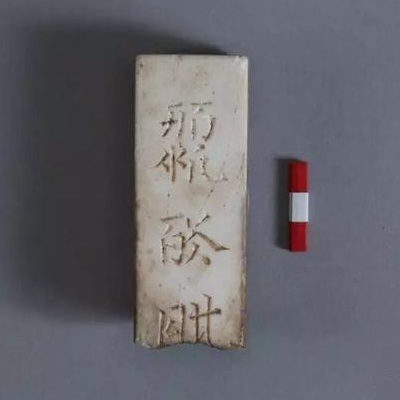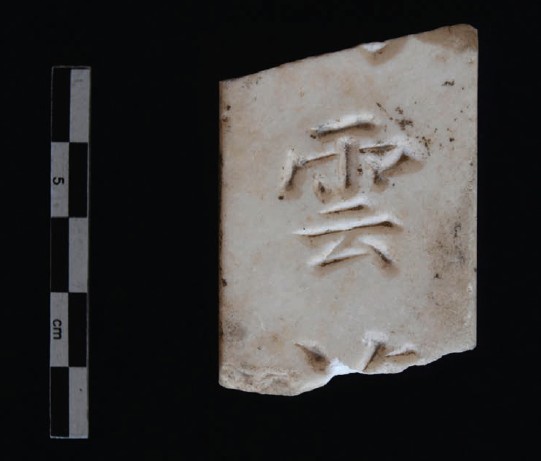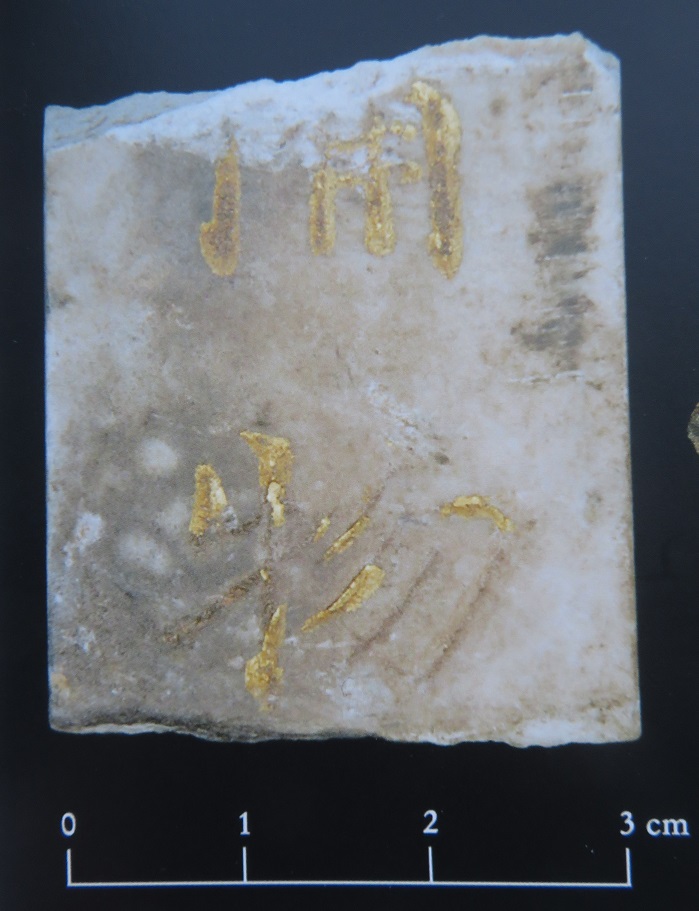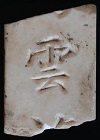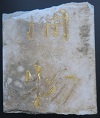BabelStone Blog
Tuesday, 1 October 2019
Fragments of Tang Inscriptions from Karabalgasun
The city of Karabalgasun (Mongolian for "Black City") was the capital of the Uighur Khaganate between 744 or 745 and 840. The ruins of the city are located on the west side of the Orkhon River in central Mongolia.
Location of Karabalgasun
47°25'52.7" N 102°39'32.8" E
Since 2007 the Mongolian-German Orchon-Expedition (Mongolisch-Deutsche Orchon-Expedition) has been exploring and excavating the site.
Laser scan plan of the Karabalgasun site
Plan of the northeastern area of Karabalgasun, where the excavations of the KAAK are focussed
Monument at HB1 with inscription in three scripts (Uighur, Sogdian, and Chinese)
Part of a monument with inscription in three scripts dated 832. In addition to the Sogdian shown here, there are also fragments of Uighur and Chinese inscriptions.
Excavation of the portico and courtyard of the citadel
Looking north to the portico and the courtyard behind the wooden threshold with covered walk (2014 season)
2017 excavation in the centre of the citadel (HB2)
Above the podium of the western room, where the stone setting at the citadel base was uncovered
Hexagonal stone setting under the citadel podium
The function of this structure has not yet been conclusively determined, but the most plausible interpretation is that it is a water well. In the section can be seen wood from a box-like structure above the stone setting.
Fragment 1
The photograph that particularly drew my attention was that of a fragment of "jade" engraved with three Chinese characters that was found in the pit filling of the citadel courtyard.
Fragment of a "jade book"
Fragment of a so-called "Jade Book" (narrow panels engraved with Chinese characters, with perforations on the sides for stringing together) from the pit filling in the courtyard of the citadel
The context of the find is described on the Mongolisch-Deutsche Orchon-Expedition site as below.
Noch nicht abschließend geklärt ist der Befund einer großen Grube im Zentrum der Zitadelle, die die umgebenden Strukturen stört und als senkrechter Schacht von etwa 3 m Durchmesser unter das Laufniveau des Hofbereiches zieht. Sie enthält alternierende Schichten aus Brandschüttungen und Schutt, der sich aus Ziegelbruch sowie weiteren Architekturelementen der Zitadelle zusammensetzt. Neben einigen Fragmenten von „Jadebüchern“ (polierten Jadetäfelchen mit chinesischen, golden inkrustierten Schriftzeichen) kam ein vollständig erhaltenes Falkenskelett in der Grubeneinfüllung zu Tage. Das durch die Radiokarbonmethode ermittelte Alter der Knochen verweist in die protomongolische Kitan-Zeit, in den darunter liegenden Schichten konnte allerdings immer wieder uighurische Keramik geborgen werden.
Not yet finally clarified is the finding of a large pit in the center of the citadel, which disturbs the surrounding structures and pulls as a vertical shaft of about 3 m in diameter below the running level of the courtyard area. It contains alternating layers of piles of fires and debris, which consists of broken brick and other architectural elements of the citadel. In addition to a few fragments of "Jade books" (polished jade tablets with Chinese, gold-encrusted characters), a completely preserved falcon skeleton in the pit filling came to light. The age of the bones, as determined by the radiocarbon method, refers to the protomongolic Kitan period, but in the underlying layers it was always possible to salvage Uyghur ceramics.
Google Translate
The stone is not actually jade (jadeite or nephrite), but is a type of fine-grained marble called 珉 mín (my thanks to Jin Xu for this identification). Although only the middle character of the fragment is complete, the preceding and following characters are not difficult to identify, and the three characters together read:
| 没 | mò | "to sink" |
| 蜜 | mì | "honey" |
| 施 | shī | "to bestow" |
This sequence of three characters 没蜜施 does not make any sense as Chinese, but are here used to transcribe the Old Uyghur word bolmïš "to have become" (from bol- "to be, to become" plus perfect participle -mïš) or bulmïš "to have received" (from bul- "to find, to get, to receive" plus perfect participle -mïš) which both occur in the titles of nine Uighur khans between 747 and 848, as recorded in the Old Book of Tang (舊唐書 Jiù Tángshū) and New Book of Tang (新唐書 Xīn Tángshū). There is some confusion over the two words bolmïš "to have become" and bulmïš "to have received" as they are both written the same in the Old Uighur and Old Turkic scripts, and are both transcribed as 没蜜施 or 没密施 mò mì shī in Chinese (没 is pronounced mut⁶ in Cantonese), which suggests to me that they should be the same word. When directly following the word täŋridä "heaven with locative-ablative ending", the word is normally read as bolmïš, so "made by Heaven" or "Heaven-born":
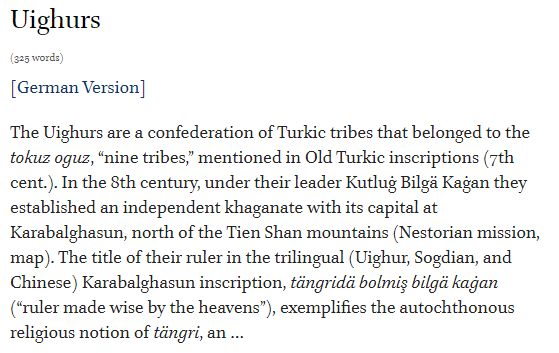
Karénina Kollmar-Paulenz, "Uighurs", in Religion Past and Present (2011)

Per Kværne, "Mongols and Khitans in a 14th-century Tibetan Bonpo Text", in Forty-five Years of Tibetan Studies. An Anthology of Articles by Per Kværne (2015) p. 39
On the other hand, where the word is separated from täŋridä by qut "luck, blessing, dignity, majesty, spirit, ..." or ülüg "lot, destiny, good fate" the word is normally read as "bulmïš" and translated as "received":
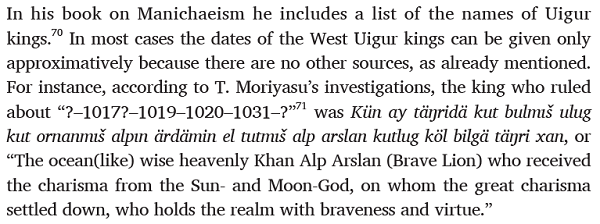
Peter Zieme, The West Uigur Kingdom: Views from Inside (June 2014) p. 16
However, not infrequently the translation "receive" is incorrectly applied to the transcription "bolmïš":
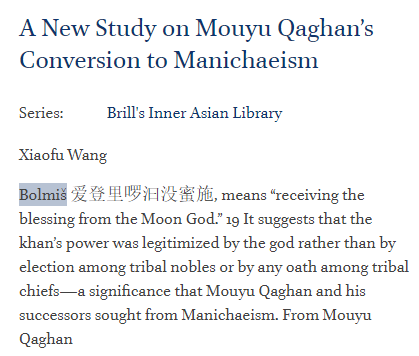
Xiaofu Wang, "A New Study on Mouyu Qaghan's Conversion to Manichaeism", in Great Journeys across the Pamir Mountains (2018)
In the example below from the New Book of Tang, the Chongde Khagan (ruled 821–824) is named as 登囉羽錄没蜜施句主毗伽崇德可汗 (dēngluó yǔlù mòmìshī jùzhǔ píqié chóngdé kěhàn), which corresponds to the Old Uighur epithet kün täŋridä ülüg bulmïš küčlüg bilgä qaɣan "powerful and wise khagan who received destiny from the sun god" intermixed with the title Chóngdé "Lofty Virtue" which was conferred on him by the Tang court.
Chinese text referencing the epithet of the Chongde Khagan
New Book of Tang 217B:1a
Fragment 2
Although the Mongolisch-Deutsche Orchon-Expedition web site only provides a single photograph of a single fragment of the "jade book", it states that several fragments were found, and the report of the 2015–2017 seasons gives a photograph of another fragment with five Chinese characters.
Jade fragment with Chinese inscription

Christina Franken, Hendrik Rohland, Ulambayar Erdenebat,Tumurochir Batbayar, Die Ausgrabungen im Bereich der Zitadelle der altenuighurischen Hauptstadt: Die Arbeiten der Jahre 2015 bis 2017 (e-Forschungsberichte 2018 Faszikel 2 pp. 99–105) Fig. 11
Fragment of a "jade book" with Chinese inscription from the well of the citadel, with a hole at the top for stringing together with other pieces; the gold encrustation on the characters is mostly lost.
Dimensions: 13.0 × 2.8 cm. (Photo: M. Riemer)
| 於 | yú | "at" |
| 天 | tiān | "heaven" |
| 下 | xià | "under" |
| 氣 | qì | "vital energy" |
| 無 | wú | "without" |
These five characters come from a composition by the famous Tang official and poet Bái Jūyì 白居易 (772–846). Bái Jūyì was instrumental in writing several memorials and other documents relating to diplomatic dealings between the Tang court and the Uighur court, including a letter regarding the exchange of horses and silk written in 809 in the name of Emperor Xianzong of Tang (reigned 805–820). Although Bái Jūyì had created an elaborate genealogy for his family, tracing his ancestors back to prominent ancient Han Chinese families, some modern scholars believe that his ancestry is fabricated, and that his family are actually of Turkic descent, hailing from Kucha in Central Asia (see Sanping Chen, Multicultural China in the Early Middle Ages (University of Pennsylvania Press, 2012) pp. 158–162 for discussion). If this is true, it may explain why Bái Jūyì was chosen to write letters and documents to the Uighur court; maybe he even had some understanding of the Uighur language.
In Spring 820, Emperor Xianzong died, and his son was enthroned as Emperor Muzong ( reigned 820‑824). A year later (early in 821), during the second year of his reign, the Uighur khagan Bǎoyì 保義, who had reigned since 808, died, and his son was made the new khagan of the Uighurs. The Tang court held three days of mourning for the death of the khagan, and in the 4th month the emperor dispatched his minister Péi Tōng to the Uighur court to present his condolences for the death of Bǎoyì and to present the Tang court's investiture of the new khagan with the title Chóngdé "Lofty Virtue" 崇德可汗.
The old khagan had tried in vain to arrange a marriage alliance with Emperor Xianzong, but the emperor had never agreed to it. As late as 820 he had sent Hedagan (合達干) as an envoy to the newly enthroned Emperor Muzong to ask again for a marriage alliance, and this time the new emperor agreed to the request, and promised him the hand of Princess Yǒng'ān (永安公主) in marriage. The death of Bǎoyì meant that the marriage never took place, and the princess retired to a nunnery. It was no surprise that immediately after his accession to the title, the new khagan sent an envoy to the Tang court to ask for a marriage alliance between himself and the new Tang emperor. Emperor Muzong agreed to give him his younger sister, Princess Tàihé (太和公主), in marriage. In the 5th month Chóngdé sent a huge embassy of two thousand men with gifts of twenty thousand horses and a thousand camels. This was the largest embassy that the Tang court had ever seen, and the emperor allowed an entourage of 573 people (including high officials, two princesses, and Manichaean priests) to continue on to the capital at Chang'an while the remainder waited at the northern capital Taiyuan.
On the 27th day of the 7th month, the Princess Tàihé set off for the Uighur capital at Karabalgasun, accompanied by Hú Zhèng 胡証 as envoy, Lǐ Xiàn 李憲 as vice-envoy, Lǐ Ruì 李鋭 as matrimonial envoy, and various other officials. It was sometime the following year that the entourage finally reached the Uighur capital, and Princess Tàihé was married to the khagan and made khatun. The Chinese officials accompanying the princess arrived back at Chang'an on the first day of the intercalary 10th month of that year (822).
Bái Jūyì wrote two official compositions in the name of Emperor Muzong relating to these diplomatic endeavours. The first was the Investiture Text written in the 4th month of the 1st year of the Changqing era, which does not mention marriage, and was intended to be presented to the new khagan by Péi Tōng and Jiǎ Lín (second son of Jiǎ Dān but not mentioned at all in either the Old Book of Tang or the New Book of Tang).
册新回鶻可汗文
維長慶元年歲次辛丑四月庚寅朔二十一日庚戌,皇帝若曰:唐有天下,垂二百載,列聖垂拱,八荒即敘,舟車之所及,日月之所照,威綏仁董,罔不向化。惟北之氣,積厚而靈,靈發象生,生為豪傑,義信武烈,代為名王。南西東方,亦有君長,較雄鬥智,莫之與京。國朝已來,浸漬風澤,或效功伐,或申婚媾,同和協比,以訖於今。今朕不得,祗嗣大統,推義布信,以初為常。矧乎柔遠申恩,睦鄰展禮,茲為舊典,垂自祖宗,虔奉恭行,安敢失墜?諮爾九姓回鶻君登里羅羽錄殁密施句主錄毗伽可汗,地生奇特,天賜勇智,英姿所蒞,雄略所加,諸戎雜虜,愛畏柔服,風靡山立,清寧一方。宜人有土,受天百祿,時推代嗣,實來告予。曰予一人,實鄰册命,是用遣使朝議大夫、檢校左散騎常侍、兼少府監、御史大夫、雲騎尉、賜紫金魚袋裴通、副使朝議大夫、守少府少監、兼御史中丞、襲魏國公、食邑三千户賜紫金魚袋賈疄等,持節備物,册為登里羅羽錄没密施句主錄毗伽可汗。於戲!善必有鄰,德無不答,此崇恩禮,則彼竭信誠,克保大義,永藩中夏。昭昭天地,實聞斯言。
Text for the Investiture of the New Khagan of the Uighurs
In the first year of the Changqing era (xīnchǒu cyclical year) [821], on the twenty-first day (gēngxū cyclical day) of the fourth month starting on the gēngyín cyclical day*, the Emperor spoke thus:
Tang has ruled all under Heaven, for two hundred years or more.
The line of sage emperors reign with ease, and the tribes in the eight directions come to pay homage.
Wherever carts and boats travel, wherever the sun and the moon shine upon,
Our might imposes peace with humane government, there are none who do not submit to it.
Only the aura in the north, it gathers thickly and is spiritually efficacious.
As the efficacious spirit develops omens arise, giving birth to heroes and men of valour.
Righteous and trustworthy, valiant and unyielding, every generation are famous kings.
In the south, west, and east quarters, there are also lords and chieftains,
Who compete for power and battle their wits, but none are as great as you.
Since the founding of our dynasty, you have soaked in our bounty.
Sometimes you attack and invade on our behalf, sometimes you seek a marriage alliance with us.
We have coexisted in peace and been allies together, right up to the present day.
Now We cannot but, respectfully continue the great unity.
Promoting righteousness and spreading trust, as it was in the beginning so shall it be forever.
Moreover, pacifying distant peoples and extending our favours, living in harmony with our neighbours and extending them our courtesies,
This is in accordance with the ancient books of rites, which have come down from our ancestors,
And which we respectfully receive and put into practice. How could we dare to abandon them?We hear that the Uighur lord of your nine tribes is called Täŋridä Ülüg Bulmïš Küčlüg Bilgä Qaɣan:
Earth gave birth to someone rare and special, Heaven bestowed bravery and intelligence.
Invested with a heroic bearing, given a majestic sense of strategy.
All the barbarians and various tribes, with love and fear tamely follow him.
Where the wind flattens the grass a mountain stands, a region of peace and tranquillity.
It is proper that men possess land, and that they receive a hundred blessings from heaven.
It is time to hand over to a new generation, and you sincerely come to ask me.
Saying I Alone, steadfastly invest you.
Because of this we dispatch as envoy Pei Tong, Grand Master for Court Discussion, Acting Cavalier Attendant-in-ordinary of the Left, concurrently Director for Imperial Manufactories, Censor-in-chief, and Commandant of Fleet-as-clouds Cavalry, Awarded the Purple and Gold Fish Tally-Bag, and as vice-envoy Jiǎ Lín, Grand Master for Court Discussion, Sub-director for Imperial Manufactories, concurrently Palace Aide to the Censor-in-chief, hereditary Duke of Wei with an estate of three thousand households, Awarded the Purple and Gold Fish Tally-Bag, and others, carrying tallies and bearing gifts, to invest you as Täŋridä Ülüg Bulmïš Küčlüg Bilgä Qaɣan.
Alas!
Goodness inevitably attracts likeminded companions, virtue will never not be answered.
If this person esteems kindness and politeness, then the other person will be honest and trustworthy to their utmost.
If one can maintain great righteousness, then one will forever protect China.
Bright and clear heaven and earth, sincerely listen to these words.
* The cyclical days do not match those for the 4th month of Changqing 1 (xīnchǒu cyclical year), which should be dīngmǎo 丁卯 for the first day of the month (shuò 朔) and dīnghài 丁亥 for the 21st day of the month. The cyclical days given in the text are twenty-three days later than expected.
The second composition was also written in 821, although the extant text has no exact date and the names of the officials are left blank, so this must be the version of the text before it was presented to Emperor Muzong for approval. The main theme of this text is the marriage alliance between the Tang emperor and the Uighur khagan, so it must have been composed for presentation to the khagan by the envoys accompanying Princess Tàihé to Karabalgasun.
册回鶻可汗加號文
維長慶元年歲次辛丑某月朔某日,皇帝若曰:北方之強,代有君長,作殿元朔,賓於皇唐。粵我祖宗,錫乃婚媾,五聖六紀,二邦一家,此無北伐之師,彼無南牧之馬,兵匣鋒刃,使長子孫,葉德保和,以至今日。諮爾回鶻君登里羅羽錄殁密施句主錄毗伽可汗,義智忠肅,武決勇健,天之所授,時而後生,故東漸海夷,西亘山狄,惠寧威制,鱗帖草偃,聲有聞於天下,氣無敵於荒外。而能事大圖遠,納忠貢誠,請仍舊姻,誓嗣前好。朕惟睦鄰是務,柔遠為心,既降和親之命,遂申飾配之禮。禮物大備,寵章有加,喜動陰山,光增昴宿。夫以回鶻雄傑如彼,慶榮若此,雖自貴曰天驕子,未稱其盛,雖自尊曰天可汗,未稱其美,宜賜嘉號,以大誇將來。今遣使某官某、副使某官某等持節加册為信義勇智雄重貴壽天親可汗。於戲!厘降展親,大德也;進册加號,大名也。宜乎思大德,稱大名,懋哉始終,欽若唐之休命。
Text for the Investiture of the Khagan of the Uighurs with a Title
In the first year of the Changqing era (xīnchǒu cyclical year) [821], on a certain day of a certain month, Emperor spoke thus:
The might of the north, every generation there are chieftains,
Making a palace in the primal north, as a guest to the august Tang.
Our ancestors, they offered you a marriage,
The five sages defined six relationships, we are two countries but one family.
One side does not send its armies to attack the north, the other side does not lead its horses to graze in the south.
Sharp weapons are sheathed, allowing children and grandchildren to grow up,
Generations of virtuous men have protected the peace, right up to the present day.We hear that the Uighur lord is called Täŋridä Ülüg Bulmïš Küčlüg Bilgä Qaɣan:
Righteous, wise, loyal and solemn; martial, determined, brave and strong.
What is received from Heaven, time and time again is found in later generations.
Therefore, bordering the sea in the east are the Yi, all across the mountains in the west are the Di.
Kindness and peace come with a strong rule, the grass bends to the wind like fish scales.
Your fame is heard throughout the world, your spirit is uncontested in the distant wilderness.
But in order to be able to implement the great plan at a distance, to pledge loyalty and express sincerity,
Let us renew the old marriage alliance, and promise to continue our previous good relations.
I only strive to achieve harmony with our neighbours, pacifying the distant parts is my heart's desire.
Having received your request to come together in marriage, so we extend to you the nuptial rites.
We have prepared many ritual objects, and laid out robes of high office,
Our pleasure moves the Shadowy Mountains, and brightens up the Pleiades.
With the Uighur's outstanding ability like that, and celebrations and glory honour like this,
Although I honour myself as favoured son of Heaven, there has never been such abundance,
Although you venerate yourself as Heavenly Khagan, there has never been such splendour.
It is proper that I bestow a fine title on you, in order that you will be greatly praised in the future.Now we dispatch as envoy a certain official and as vice-envoy a certain official, and others, carrying tallies to invest you as Trustworthy-and-Righteous, Brave-and-Wise, Majestic-and-Generous, Noble-and-Long-living Related-to-Heaven Khagan.
Alas!
When Yáo married two daughters to Shùn, that was because of his great virtue.
Presenting this investiture and giving you a title, this is to give you a great name.
It is right to think of your great virtue, and so call you by a great name.
Wonderful! From beginning to end, you will respectfully follow the good orders of the Tang.
The fragment of stone from Karabalgasun engraved with the five Chinese characters 於天下氣無 must come from the above composition as there is no other Chinese text that I can find with this exact sequence of five characters. The other stone fragment engraved with the three characters 没蜜施 most probably also comes from this same text written by Bái Jūyì, although in the extant copies of his writings the characters are written as 殁密施 in two cases (the three characters occur in both texts quoted above, so it is also possible that the stone fragments represent both texts).
The five-character fragment has a hole in the sides at the top, and the engraved stone tablets would have been strung together to form a stone document. Such tablets were used during the Tang and Song dynasties to engrave investiture texts (册, 册命, 册封) and other important imperial documents. Although commonly referred to as "jade books" (玉册 yùcè), they were normally not actually made from jade, but from a type of fine-grained white marble known as 珉 mín or 瑉 mín (described as 珉石方如雪 in a Tang poem by Lǐ Xiányòng). The History of the Song (vol. 154) describes investiture tablets made out of marble (mín) for the emperor, empress and crown prince, each one being one foot and two inches in length and 1.2 inches wide:
冊制。用珉玉,簡長一尺二寸,闊一寸二分;簡數從字之多少。聯以金繩,首尾結帶。前後褾首四枚,二枚畫神,二枚刻龍鏤金,若奉護之狀。藉以錦褥,覆以緋羅泥金夾帊。冊匣長廣取容冊,塗以朱漆,金鏤百花凸起行龍,金鏁、帉錔。覆以紅羅繡盤龍蹙金帊,承以金裝長竿床,金龍首,金魚鉤,又以紅絲為絛縈匣。冊案塗朱漆,以銷金紅羅覆之。
后冊,用珉,或以象。縷文以鳳。尺寸制度並同帝冊。
皇太子冊,用珉簡六十枚,乾道中,用七十五枚,每枚高尺二寸,博一寸二分。前後褾首四枚,長隨簡,博四寸,其二刻神,其二刻龍,為奉護狀。貫以金絲,首尾結為金花,飾以帉錔。襯以紅羅泥金夾帕,藉以錦褥,盛以黝漆匣,錦拓裏,以金塗銀葉段五明裝,隱起百花鳳。覆以緋羅泥金帕,絡以紅絲結絛,襯以錦褥,載以黝漆腰輿、行馬。
Several examples of marble or jade books dating from the Tang dynasty and later are shown below.
A. These are the remnants of a jade book used to announce the accession to the throne of the last Tang emperor (r. 904–907):
Jade Book for Emperor Ai of Tang (唐哀帝玉册)
B. This is a complete set of bound white marble tablets made for the sacrifice to the earth by Emperor Xuanzong of Tang in the 3rd year of the Kaiyuan era (725):
Bound tablets for the Shan sacrifices to the earth by Emperor Xuanzong of Tang in 725 (唐玄宗開元十三年禪地衹玉册)
Source: Bound tablets for the Shan sacrifices to the earth by Emperor Hsuan-tsung (唐玄宗開元十三年 禪地衹玉册)
C. This is a complete set of bound white marble tablets made for the sacrifice to the earth by Emperor Zhenzong of Song in the 1st year of the Xiangfu era (1008):
Bound tablets for the Shan sacrifices to the earth by Emperor Zhenzong of Song in 1008 (宋真宗大中祥符元年封禪玉册)
Source: Jade Album of slips inscribed with the ritual shan prayer to Land Deity (象徵法統的「封禪」玉冊)
D. This is a fragment of a jade tablet engraved with Khitan small script found at a Liao dynasty tomb in Liaoning in 2018:
Jade fragment with Khitan small script inscription
Khitan Fragment from the Liao Mausoleum at Yiwulü Mountain
Evidently the two inscribed marble fragments found at Karabalgasun are the remains of the investiture tablets for the marriage alliance with Chóngdé Khagan made at the Tang court in 821, and engraved with the text of Bái Jūyì's composition at the command of Emperor Muzong. The finished product would surely have been sent to the Uighur court at Karabalgasun with the entourage of Princess Tàihé to be formally presented to the khagan. To my mind these fragments are a hugely important find, and I only hope that more pieces can be recovered from the excavations at Karabalgasun.
Addendum I [2019-10-11]
After I wrote this blog post I found this paper from 2011 which discusses two additional inscribed marble fragments from Karabalgasun:
- Lyndon A. Arden-Wong, "Preliminary Thoughts on the Marble Inscriptions from Karabalgasun"; Journal of Inner Asian Art and Archaeology Volume 6 (2011): 75–100.
KB001 is a marble fragment which was found in 2009 in the main palace buildings in the north of the city. It is 4.05cm long, 3.3cm wide, and 1.4cm thick, engraved with the remnants of three Chinese characters, but only the middle character is complete and identifiable. The middle character, 雲 yún "cloud", does not occur in Bái Jūyì's Text for the Investiture of the Khagan of the Uighurs with a Title《册回鶻可汗加號文》, but does occur a single time in Bái Jūyì's Text for the Investiture of the New Khagan of the Uighurs 《册新回鶻可汗文》 in the titles 御史大夫、雲騎尉 "Censor-in-chief, and Commandant of Fleet-as-clouds Cavalry". However, the remains of the top of the character below 雲 on the fragment (possibly 施 shī or 於 yú) do not match the character 騎 following 雲 in this text. Therefore, it is likely that this fragment belongs to a different jade book than those for either of Bái Jūyì's investiture texts.
Obverse side of fragment KB001
Lyndon A. Arden-Wong, "Preliminary Thoughts on the Marble Inscriptions from Karabalgasun"; Journal of Inner Asian Art and Archaeology Volume 6 (2011): Plate 1a
KB002 is a marble fragment which was found in 2011 in the backfill of a trench in the palace-temple complex that was dug by S. I. Kiselev in 1948–1949. It is 7.1cm long, 3.0cm wide, and 1.1cm thick, engraved with three Chinese characters. Particles of gold dust were found in the soil attached to the front surface. The first two engraved characters are 較雄 jiào xióng, and although the third character is obscured by an earthen crust, it can just about be identified as the top part of the character 鬥 dòu. The three characters "較雄鬥" occur in Bái Jūyì's Text for the Investiture of the New Khagan of the Uighurs 《册新回鶻可汗文》: 南西東方,亦有君長,較雄鬥智,莫之與京 "In the south, west, and east quarters, there are also lords and chieftains, Who compete for power and battle their wits, but none are as great as you". Thus, it seems that the marble fragments from Karabalgasun represent at least two jade books engraved with the text from the two investiture texts composed in 821 by Bái Jūyì that I translated above.
Obverse side of fragment KB002
Lyndon A. Arden-Wong, "Preliminary Thoughts on the Marble Inscriptions from Karabalgasun"; Journal of Inner Asian Art and Archaeology Volume 6 (2011): Plate Fig. 2a
Addendum II [2020-02-06]
Today I received a copy of the marvellous The Ruins of Kocho: Traces of Wooden Architecture on the Ancient Silk Road edited by Lilla Russell-Smith and Ines Konczak-Nagel, published by the Museum für Asiatische Kunst — Staatliche Museen zu Berlin in 2016 (ISBN 978-3-88609-786-9). Part 1 of the book includes two sections on the excavations at Karabalgasun, and on page 33 Fig. 9 C) there is a photograph of a "Fragment of a jade tablet with Chinese letters" excavated from Karabalgasun and now held at the Kharakhorum Museum in Kharkhorin, Mongolia. This small rectangular fragment is made from white marble, and is engraved with two Chinese characters covered in gold leaf. It is clearly part of the same set of marble texts discussed above, and the two Chinese characters (the first one missing the top half) can be identified as 備物 bèi wù "bearing gifts" which occur near the end of the Text for the Investiture of the New Khagan of the Uighurs 《册新回鶻可汗文》.
Fragment in The Ruins of Kocho
Christina Franken, "Excavations in the Old Uygur Capital Karabalgasun — Some New Results"; in The Ruins of Kocho: Traces of Wooden Architecture on the Ancient Silk Road (Berlin: Museum für Asiatische Kunst — Staatliche Museen zu Berlin, 2016) pp. 27–34: Fig. 9 C "Fragment of a jade tablet with Chinese letters"
© H.-P. Wittersheim, DAI Bonn.
Summary of Inscribed Marble Fragments from Karabalgasun
I currently know of five marble fragments from Karabalgasun inscribed with Chinese writing, which derive from two texts composed in 821 by Bái Jūyì (Text for the Investiture of the New Khagan of the Uighurs 《册新回鶻可汗文》 and Text for the Investiture of the Khagan of the Uighurs with a Title《册回鶻可汗加號文》), as well as one other unknown text.
Archaeology | History | Marble Slips | Uighur
Index of BabelStone Blog Posts
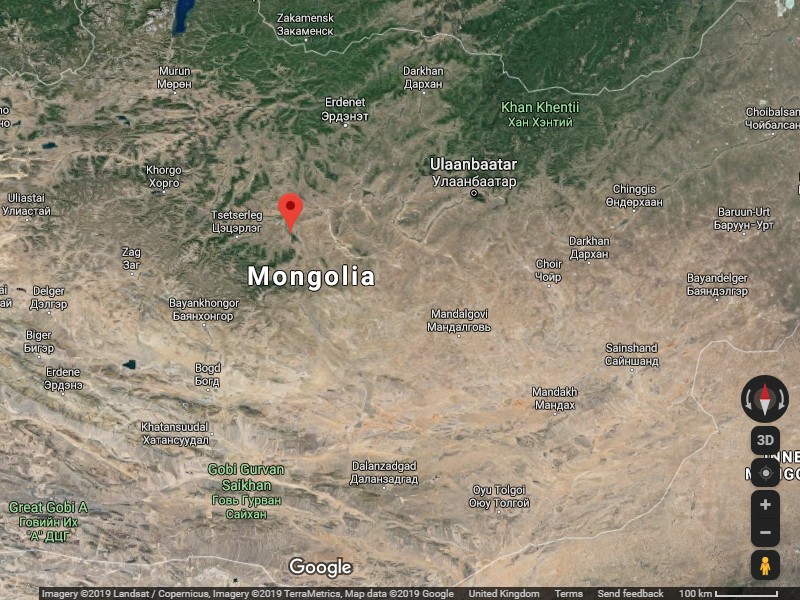

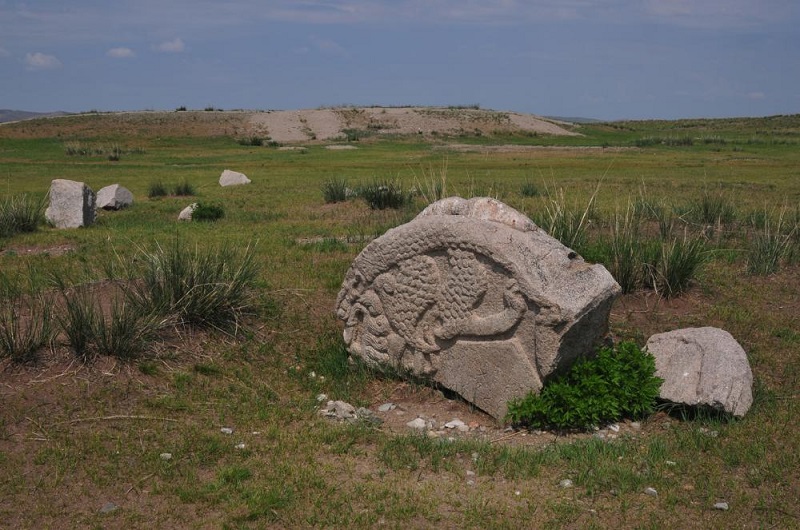

.jpg)
